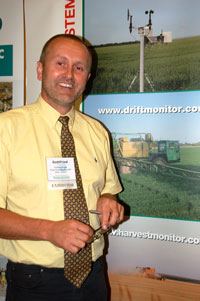 There are two kinds of information that are important for Pessl Instruments: “ground truth” and expected forecasts. The Austria-based company claims that it offers a one-of-a-kind tool for farmers:
There are two kinds of information that are important for Pessl Instruments: “ground truth” and expected forecasts. The Austria-based company claims that it offers a one-of-a-kind tool for farmers:
“What we do is we measure the ground truth,” Gottfried Pessl, President of Pessl Instruments said. “That means what’s going on actually on the field of the farmers but we now also bring in the weather forecast. The weather forecast comes from a Swiss company we have teamed up with and this Swiss company delivers us a five day weather forecast in real-time for that particular farm.”
Gottfried adds that the technology is based entirely on the internet giving farmers the option of accessing the “ground truth” and weather forecast information on any internet capable electronic device, such as a cell phone.
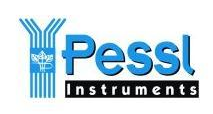 “We have a wireless system which brings the data in a centralized server and through that centralized server our clients can worldwide have real time access to the data,” Gottfried said.
“We have a wireless system which brings the data in a centralized server and through that centralized server our clients can worldwide have real time access to the data,” Gottfried said.
The information collected from Pessl Instruments, Gottfried explained, is valuable for irrigation management for plant protection requirements. He says the collected data can help farmers “optimize the use of the chemicals, to prevent the diseases to prevent insect pest outbreaks and also to have a full traceability of their crop.” Plus, he says using weather forecast data together with real-time weather helps farmers schedule their farm operations associated with the weather, such as harvest sprays.
“Most of the activities on the farm are very much dependent on if the weather is good or the weather is bad,” Gottfried said.
The company now exports tools and technology to about 70 countries.
I interviewed Gottfried about his products and technology. You can listen to my interview with Gottfried here:
gottfried-pessl-preag-08.mp3
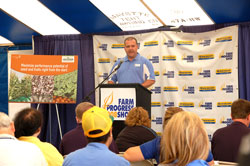 The Monsanto press conference is just over and I recorded it on AgWired Live TV so you can watch it below. Randy Barker, Monsanto’s Global Strategy Lead for Seed Treatments, spoke before a crowd of journalists and farmers about the launch of Monsanto’s new Acceleron brand seed treatment. Monsanto says Acceleron helps maximize potential for crop performance from the very start, at planting. Acceleron products are designed for use with soybean, corn and cotton and boast early season protection from farming hazards, such as diseases and insects.
The Monsanto press conference is just over and I recorded it on AgWired Live TV so you can watch it below. Randy Barker, Monsanto’s Global Strategy Lead for Seed Treatments, spoke before a crowd of journalists and farmers about the launch of Monsanto’s new Acceleron brand seed treatment. Monsanto says Acceleron helps maximize potential for crop performance from the very start, at planting. Acceleron products are designed for use with soybean, corn and cotton and boast early season protection from farming hazards, such as diseases and insects. and
and 

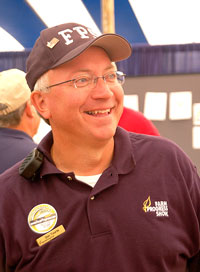 It feels more like fall and not late August this morning at the Farm Progress Show. And, that’s a good thing. Farm Progress is hoping the beautiful, mild weather will draw more participants to this year’s show in Boone, Iowa. Don Tourte, National Sales Director for Farm Progress Companies says participants will have more to see this year. The exhibition site is the largest in Farm Progress history witha five percent growth from last year’s record exhibition area.
It feels more like fall and not late August this morning at the Farm Progress Show. And, that’s a good thing. Farm Progress is hoping the beautiful, mild weather will draw more participants to this year’s show in Boone, Iowa. Don Tourte, National Sales Director for Farm Progress Companies says participants will have more to see this year. The exhibition site is the largest in Farm Progress history witha five percent growth from last year’s record exhibition area. 
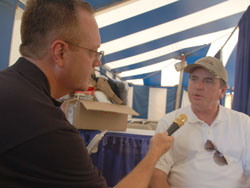 AgWired has arrived at the Farm Progress Show and the first person I got to meet is the new VP, Sales and Marketing, New Holland Agricultural Equipment NA. He’s John Stevenson and this is his first Farm Progress Show. Thanks to Laura McNamara for taking our picture.
AgWired has arrived at the Farm Progress Show and the first person I got to meet is the new VP, Sales and Marketing, New Holland Agricultural Equipment NA. He’s John Stevenson and this is his first Farm Progress Show. Thanks to Laura McNamara for taking our picture.

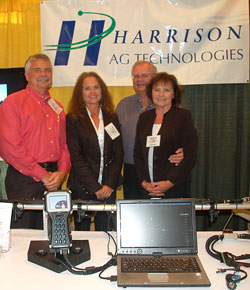 The Smart Nozzle does exactly what it sounds like it does. It’s a boom nozzle that can operate independently during sprayer operations. John Harrison Jr. is the Product Engineer for
The Smart Nozzle does exactly what it sounds like it does. It’s a boom nozzle that can operate independently during sprayer operations. John Harrison Jr. is the Product Engineer for  There are two kinds of information that are important for
There are two kinds of information that are important for  “We have a wireless system which brings the data in a centralized server and through that centralized server our clients can worldwide have real time access to the data,” Gottfried said.
“We have a wireless system which brings the data in a centralized server and through that centralized server our clients can worldwide have real time access to the data,” Gottfried said.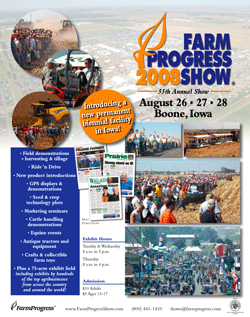 I hope you’ve got all your Farm Progress Show preparations made. I’m still getting my stuff together.
I hope you’ve got all your Farm Progress Show preparations made. I’m still getting my stuff together.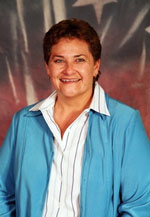 In case you need a little reminder and encouragement to get your plans made for the NAFB Convention, then Pam Jahnke, Fabulous Farm Babe, has it:
In case you need a little reminder and encouragement to get your plans made for the NAFB Convention, then Pam Jahnke, Fabulous Farm Babe, has it: